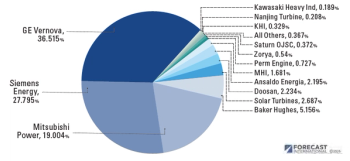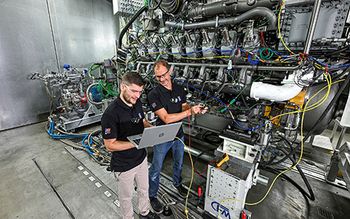
Myth Busters: Myth- Don't Run A Centrifugal Compressor In Recycle
Unlike the previous myth, this one does not involve a girlfriend, but only a phobia about operating centrifugal compressors in recycle. In oil and gas compression applications, centrifugal compressors usually have to operate over a wide range of operating conditions. In many instances, these operating points involve both conditions that the units will frequently see, as well as conditions that will only happen a few times a year, or some that may never occur.
When specifying a compressor, operators often desire that all operating conditions are met without recycling gas. While it seems intuitively justified to avoid recycling gas for efficiency reasons, this intuition might be wrong. Consider a situation where five operating points are specified that are coarsely spread over a wide range of head and flow requirements on the compressor map.
Some points are at lower flows, some at higher flows. If recycling is not allowed, the compressor sizing is determined by the requirements for the lowest flow point, i.e., this point has to be on the map, with at least some safe surge margin, typically about 15%. If the flow requirements are widely spread, the high flow points might be in the choke region, or at least on the low efficiency region of the compressor map.
Because of the low efficiency, they also might be the points with the highest power requirements, thus determining the driver size. In other words, the amount of installed power, and with it the capital and operating expense, would increase.
Also, some compressor models have limitations on their life if they operate for extended period in or near choke. If all points have about the same frequency of operation, the requirement for no recycle might be justified if the concern is fuel consumption.
If, however, the unit is operated at high flow more often than at low flow, the efficiency penalty at the high flow points often more that makes up for the fuel savings from not recycling.
Often, the extreme points of operating conditions are defined by conditions that occur over a span of many years. In such cases, restaging the compressors, especially if it can be done with minimum disruption of the station operation, is another way to optimize operation.
Even for existing machines, recycle may be better than off-design operation. Power requirements due to recycling are linearly proportional with recycling flow rate whereas, when the compressor operates far away from its best efficiency point, power required can increase non-linearly.
Specifically, although recycling is inherently inefficient, it may not be as inefficient as operating at a condition that is very far away from the best operating point of the compressor. A simple compressor map performance analysis can show which one is the preferred approach for a single low flow operating point.
“Although recycling is inherently inefficient, it may not be as inefficient as operating . . . very far away from the best operating point of the compressor.”
It is interesting to note that both users of reciprocating compressors, as well as operators of constant speed centrifugal compressors, readily accept recycling as valid and effective method to adjust the compressor flow to process requirements.
One other point needs to be emphasized: A modern control system, with properly sized valves makes the transition from recycle to no recycle and vice versa “bumpless.” Some operators undoubtedly have experienced recycle systems, where each activation of the recycle valve led to massive fluctuations in the process, including situations where other units were forced off line.
However, some of these experiences date back to relay control systems. There is an abundance of installed compressors with incorrectly sized recycle valves. If the recycle valve is sized too big or has an inappropriate trim it is difficult to accomplish the fine-tuned control necessary for smooth operation.
Also, some older systems use the same gain for opening and closing, making the balance between fast response, and the avoidance of valve “hunting” and oscillations a daunting task. However, with a modern control system, and a valve that is properly matched to the compressor map, these issues can be avoided.
Obviously, if desired design points are tightly clustered on the compressor map and they can all be achieved without recycling, there is no reason to worry about this discussion.
However, in many cases, required flow rates vary widely and the operator should carefully review if operating in recycle for limited periods of time may be a viable alternative to specifying a compressor staging that, although it has a huge flow range, otherwise results in poor compressor performance — or requires a larger driver size than necessary.
Written by:
Klaus Brun, the Machinery Program Director at Southwest Research Institute in San Antonio, Texas. He is also the past Chair of the Board of Directors of the ASME International Gas Turbine Institute and the IGTI Oil & Gas applications committee.
Rainer Kurz, the Manager for Systems Analysis at Solar Turbines Incorporated in San Diego, CA. He is an ASME Fellow since 2003 and the chair of the IGTI Oil and Gas Applications Committee.
Newsletter
Power your knowledge with the latest in turbine technology, engineering advances, and energy solutions—subscribe to Turbomachinery International today.





